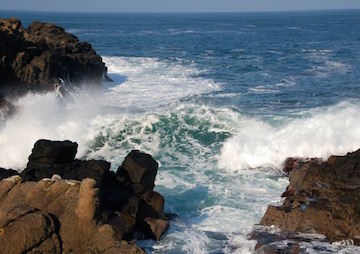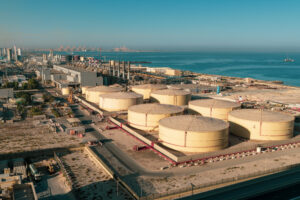New Ideas Give an Energy Boost to Wave Power
Scientists and engineers in Scandinavia reveal plans to harness the huge potential of waves to produce commercially viable renewable energy.
By Paul Brown, Climate News Network
The power of Atlantic waves could be a valuable source of renewable energy. (Albert Bridge via Wikimedia Commons)
This Creative Commons-licensed piece first appeared at Climate News Network.
LONDON — All along the coasts of Europe where the Atlantic waves crash onto the shore there are experimental wave power stations producing electricity.
Now engineers in Norway and Sweden — two of the countries trying hardest to develop this technology — have announced “breakthroughs” in their methods, which the inventors believe will make wave power competitive.
At present, most wave power stations are small-scale. All of them work, but making them commercially viable to compete economically with other renewables and fossil fuels has so far eluded their inventors.
The latest Norwegian experiment has been installed in a redundant fishing vessel in the Stadthavet area of West Norway, an area designated for renewable energy testing.
Bicycle pump principle
Like all the best ideas, it is simple. “In principle, it works almost like a bicycle pump,” explains engineer and project manager Edgar Kvernevik, of Kvernevik Engineering AS.
The makers have installed four large chambers in the vessel’s bow. As the waves strike the vessel, the water level in the chambers rises. This creates an increase in air pressure, which in turn drives four turbines — one for each chamber.
The pitch of the vessel also contributes by generating additional air pressure in the chambers when the wave height is large. The design of the chambers is such that they work in response to different wave heights, which means that the energy is exploited very effectively.
“The plant thus produces electricity with the help of what is called a fluctuating water column,” says Kvernevik, who has spent much of his working life designing and building vessels.
Our aim is to . . . produce hydrogen at a competitive price —
based on an infinite resource and involving
no harmful emissions”
“All we have to do is to let the vessel swing at anchor in a part of the ocean with sufficient wave energy. Everything is designed to be remotely-controlled from onshore.
“This floating power plant has also been equipped with a special anchoring system, which means that it is always facing into the incoming waves. This ensures that the plant is in the optimal position at all times.”
The turbines on the deck of the vessel continue to work regardless of whether the chambers are inhaling or exhaling air as the wave runs past the vessel.
In the same area, which has a high average wind velocity, researchers have been studying the idea of floating wind turbines.
The project is now looking at combining wind turbines and wave power plants on the same vessel and using the electricity to create hydrogen gas — a way of storing the energy.
“We see this project as a three-stage rocket,” Kvernevik says. “The first stage is to test the model we have just built to make sure that electricity generation can be carried out as planned.
Production plant
“Next, a hydrogen production plant will be installed on board the vessel so that the electricity generated can be stored in the form of hydrogen gas.
“We have high hopes that hydrogen will be the car fuel of the future. Our aim is to work with others to produce hydrogen at a competitive price — based on an infinite resource and involving no harmful emissions.
“The plan is then to construct a plant with a nominal capacity of 1000kW (1MW). We will do this by installing five production modules similar to the current plant, either on a larger vessel or a custom-built barge. Finally, we will build a semi-submersible platform designed to carry a 4MW wave power plant with a 6MW wind turbine installed on top.”
The Norwegian Marine Technology Research Institute (MARINTEK) is one of the project partners that have contributed towards the development of the wave power plant.
Reliable source
Meanwhile, a Swedish company claims to have cracked the problem of scaling-up wave energy with a gearbox that generates five times as much power per tonne of device at one third of the cost.
One of the obvious problems with wave power is the height and timing of the waves, making it difficult to convert the power into a reliable energy source. But CorPower Ocean’s new wave energy system claims to produce three to four times more power than traditional systems.
The new system that helps to solve this problem is based in a buoy that absorbs energy from the waves — a scaled-up version of a heart surgeon’s research into heart pumping and control functions.
Patrik Möller, CorPower’s chief executive, says the wave energy converter — in contrast to competing systems — can manage the entire spectrum of waves.
He says: “We can ensure that it always works in time with the waves, which greatly enhances the buoy’s movement and uses it all the way between the wave crest and wave trough and back in an optimal way, no matter how long or high the waves are.”
The buoys are compact and lightweight and can be manufactured at a relatively low cost. A buoy 8 metres in diameter can produce 250-300 kilowatts in a typical Atlantic swell. A wave energy park with 100 buoys can generate 25 to 30 megawatts.
Your support matters…Independent journalism is under threat and overshadowed by heavily funded mainstream media.
You can help level the playing field. Become a member.
Your tax-deductible contribution keeps us digging beneath the headlines to give you thought-provoking, investigative reporting and analysis that unearths what's really happening- without compromise.
Give today to support our courageous, independent journalists.







You need to be a supporter to comment.
There are currently no responses to this article.
Be the first to respond.